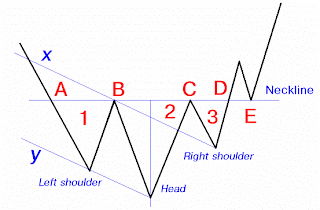As shown in Figure 5.19., in a typical triple-top formation, the tops have about the same height. A parallel line (the neckline) is drawn against the line connecting the three tops (B, D, and F.) As a resistance line, the neckline is broken at point A. It turns into a strong support for price levels at С and E, but eventually fails at point G. The support line turns into a strong resistance line, which holds the market backlash at point H. The price objective is at level I, which is the average height of the three tops formation, as measured from point D (see the dotted lines).
 |
| Figure 5.19. Diagram of a triple-top formation |
The opposite is true for the triple bottom
As shown in Figure 5.19., in a triple-bottom formation, the bottoms have about the same amplitude. A parallel line (the neckline) is drawn against the line connecting the three bottoms (B, D, and F.) As a support line, the neckline is broken at point A. It turns into a strong resistance for price levels at С and E, but eventually fails at point G. The resistance line turns into a strong support line, which holds the market backlash at point H. The price objective is at level I, which is the average length of the triple-bottom formation, as measured from point D (see the dotted lines).
 |
| Figure 5.20. Diagram of a typical triple-bottom formation. |
The rounded top and bottom, also known as saucers consist of a very slow and gradual change in the direction of the market. These patterns reflect the indecision of the market at the end of a trend. The trading activity is slow. It is impossible to know when the formation is indeed completed, and not for a lack of trying. Like any other consolidation pattern, the longer it takes to complete, the higher the likelihood of a sharp price move in the new direction.
Diamond Formation
The diamond formation tends to occur at the top of the trend. The price activity may be outlined by a shape resembling a diamond (see Figure 5.21.). The increase and decrease in trading volume closely mimic the combination of divergent and convergent support and resistance lines. Upon breakout, volume picks up substantially. The price target is the height of the diamond, measured from the breakout point.
The head-and-shoulders, the double top and bottom and the triple top and bottom, due to their significance in trend reversals, are generally known as major reversal patterns.
 |
| Figure 5.21. A scheme of a diamond reversal formation |





















